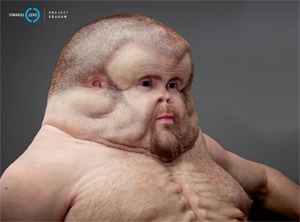
Vehicle technology has evolved rapidly over the past 100 years. From faster speeds and more reliable components to advanced safety features, vehicle manufacturers up the ante on innovation with every new model year. The one thing that has not changed much in the era of the automobile is the human body. Our bodies remain just as vulnerable to the effects of car accidents as they did the day cars were invented.
Even though safety features like seat belts and airbags are reducing traffic fatalities, human bodies are still extremely susceptible to car accident injuries.
To illustrate the fragility of the modern human, Australian safety project Towards Zero teamed up with an artist to create a lifelike rendition of a human evolved to withstand a car accident.
Graham is a lifelike sculpture designed to include features that represent what the human body would look like if it evolved alongside vehicles to prevent severe trauma in a car accident. Graham’s design identifies the most vulnerable parts of the human body in a car crash.
Graham’s brain is the same size as a modern human’s brain but is surrounded by more cerebrospinal fluid and ligaments to cushion and secure the brain during a collision. The skull is much larger to support the extra space around the brain and includes an extra outer layer designed to act as a crumple zone to slow the momentum of the head and reduce brain damage.
The artist and engineers behind Graham prevented neck strains and sprains, commonly known as whiplash, by designing him without a neck. The ribcage extends up to cradle the base of his skull, therefore eliminating neck injury and reducing rapid head movement that can lead to brain damage.
Moving down to the ribcage, this is Graham’s second most important evolution after the head. The ribcage is already an extraordinary piece of protective “armor” for the internal organs. The artist reinforced the rib bones and provided airbag-like sacks between ribs to reduce friction and absorb the force of the collision.
Finally, Graham’s team protected his arms and legs with thicker skin able to reduce the damage of road rash abrasions in pedestrian accidents. His knees are multi-jointed, allowing movement in all directions and reducing the risk of breakage upon impact.
The legs and feet are more hoof-like to allow quicker movement and vehicle avoidance as a pedestrian. The redesign also adds more joints to the legs to prevent a broken tibia, a common injury in a car accident.
Humans cannot evolve to develop Graham’s safety qualities. What we can do is live our lives as safer drivers and smarter pedestrians, following the rules of the road at all times and walking with safety in mind.
For more information on car accident injuries and safety tips, visit our blog and library.